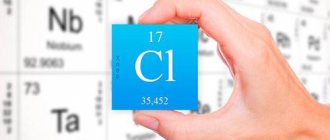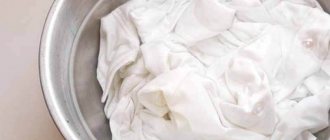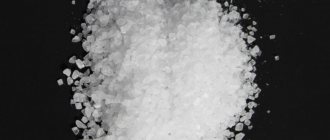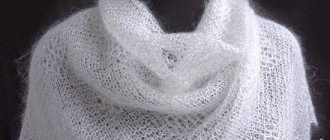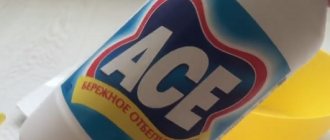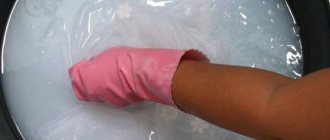Everyone has white things in their wardrobe: shirts, underwear, bedding, towels... They are pleasing to the eye, perfectly complement the image and interior, but only as long as they are in the “dazzling white” status. After frequent washing, the fabric loses its original shade, grayness and yellowness appear. You go to the supermarket and look at the cost of branded bleaches, turning the thought in your head: “Isn’t it more profitable to buy a new thing?” Don't rush to conclusions! In our article we will reveal the secrets of experienced housewives on how to bleach white clothes at home, maintaining the quality of the fabric and without resorting to expensive powders. Whiten and save!
Method No. 1. Soda
This is the most affordable option that can be found in any housewife’s kitchen. Baking soda is a natural, cheap and safe product that can be safely used to whiten both adult and children's wardrobes.
How to bleach?
Dilute 5-6 tablespoons of soda in 5 liters of water (to enhance the whitening effect, you can add a couple of tablespoons of ammonia). Soak the items in this solution for several hours (2-3), then rinse thoroughly and wash in the traditional way. If there are yellow spots on things, then they should be boiled in a soda solution.
Restoring gray fabric
Restoring a gray or washed-out white item, although not easy, is possible. It is a natural process for white fabric to wear out and turn gray. To restore the white color of guipure or any other similar fabric, you can use the following step-by-step instructions:
- First of all, prepare a large basin, plastic or stainless steel, pour about ten liters of hot or warm water into the container.
- Add 50 milliliters of ammonia and the same amount of hydrogen peroxide to the liquid, stir the water thoroughly.
- Place the washed, gray fabric in the prepared liquid for about half an hour.
- After the specified time has passed, rinse white items in clean water and then wash as usual.
After this treatment, the guipure will become white again. In this way, the whiteness of tulle or curtains is very often restored. This gentle product is suitable for restoring the color of underwear. However, it should be remembered that after treatment, the fabric should be rinsed thoroughly and then washed using a water softener.
As for white items made of natural fabric that have turned gray or worn out, you can restore their white color at home using bleaches, the effect of which is described in the previous section. If you bleach your clothes in the washing machine, be sure to use only oxygen bleach.
Synthetics do not tolerate bleaching using household chemicals very well, so to restore the whiteness of your favorite T-shirts or socks, it is best to use regular salted water. To do this, just add 40 grams of table salt per liter of warm water.
If you need to bleach gray silk or wool, it is recommended to use the only safe product - baking soda. There are many options and recipes for making bleach from baking soda, which we will discuss in more detail in the corresponding section.
In most cases, the problem of the appearance of a gray tint on white things does not even arise due to improper washing or low-quality household chemicals. It's all about the quality of the water, which contains a large number of impurities, which form a gray coating. It is formed not only on light-colored things, the effect is simply more noticeable on white. In this case, it is recommended to use special water softeners or baking soda. The ideal option is to install a cleaner on the water supply pipe to the washing machine, but this is a rather expensive procedure.
It is also very important not to wear white clothes. Experienced housewives recommend washing white items after each use, then there will be no need to restore the color
Method No. 3. Ammonia + hydrogen peroxide
Are you surprised that hydrogen peroxide can not only treat wounds, and that ammonia is not just a means of reviving? Yes, housewives have been using these compositions to whiten clothes at home for many decades. Try it too!
How to bleach?
Mix 2 tablespoons of peroxide, 1 tablespoon of ammonia and 5 liters of water. Heat the solution to 70 degrees and soak things for about 3 hours. Rinse. Using this method, you can return the whiteness to lace underwear, tulle, curtains, a white shirt and any other items made of natural fabric.
Important!
If you decide to lighten clothes made of wool or silk, then reduce the temperature of the solution to 30 degrees. Otherwise the fabric will shrink!
Proper washing of clothes.
Remember a few simple rules that will help save your laundry from unpleasant consequences:
- If there are metal elements on the clothes, then they cannot be soaked for a long time and washed only at temperatures up to 40 degrees.
- Do not bleach items that have rust stains. As a result, the entire fabric will acquire an unpleasant shade.
- It is better not to use chlorine-based bleaches when washing. They spoil the structure of the laundry.
- Be sure to read the information on the tags. There they always write the exact temperature and modes that can be used when washing.
- It is necessary to check things for the presence of foreign objects, which should be shaken out before washing.
- Make sure your laundry is completely dry before removing it from the dryer. Wet fabrics are more susceptible to developing a gray cast.
All the proposed methods will help you whiten your bed linen and remove all unpleasant shades at home. If you follow all the proportions and washing tips correctly, your clothes will shine and please the eye for a very long time.
Method No. 10. Vinegar
If you add white (distilled) vinegar when washing clothes, you can achieve a good bleaching effect. It will help preserve and restore lost whiteness, soften the fabric, and prevent the appearance of pilling.
How to bleach?
Add ½ cup of vinegar to your laundry and set the washing machine to the daily cycle. This procedure will keep things white for a long time. And ¼ cup of vinegar will help remove stains. For complex stains, you can soak the clothes in warm water with a glass of vinegar overnight. In the morning, rinse and wash your clothes well!
Other whitening products
In conclusion, here are some more interesting methods of whitening:
| Means | Method | Additionally |
| Vegetable oil | 5 liters of water + 0.5 tbsp. powder + 0.5 tbsp. soap shavings + 2.5 tbsp. l. oils Soak for 3 hours. Wash | Removes greasy stains and whitens |
| Lemon acid | For 1 liter of boiling water 1 tbsp. l. citric acid. Soak for 5 hours. Rinse | Do not use on delicate fabrics |
| Aspirin | For 1 liter of water, 1 tablet (crush). Soak for 8 hours. Rinse | Eliminates yellowness and grayness. Suitable for wool. Can be added to the machine |
| Mustard powder | For 1 liter of boiling water 1 tbsp. l. mustard powder. Leave for 3 hours, strain. Soak the laundry for 0.5-3 hours. Wash | Disinfects, removes grease, suitable for delicate items and colored prints |
Method No. 12. How to bleach white clothes from traces of sweat?
Do you like to wear white things? Love to remove sweat stains too!
How to bleach?
- Fresh traces of sweat can be whitened using laundry soap. It is enough to thoroughly soap the problem areas and leave for 30 minutes, then wash the item.
- For thick fabric, use alcohol and kitchen salt. Pour salt onto the stain and apply alcohol, leaving the item in this state for about 20 minutes. Then wash.
- Veils with yellow sweat stains can be washed in the following solution: 200 ml of ammonia, 200 ml of denatured alcohol, 800 ml of water.
Important!
If you wash white items frequently, traces of sweat will not have time to eat into the structure of the fabric. This will help keep your white item white longer.
Fabric bleach at home - ready-made products
Using ready-made bleaching products will reduce your time preparing traditional methods. You can achieve dazzling whiteness by:
- stain remover "Sarma Active 5 in 1". Fights both stubborn stains and fresh ones;
- stain remover "Vanish OXI Action". Perfectly fights against fresh stains, gives white things whiteness;
- Amway PreWash Spray stain remover. Removes fresh stains on white, but does not cope well with yellowness;
- stain remover pencil “Faberlic (Edelstar)”. Removes stains point by point; there is no need to completely wash the item in soapy water;
- powder "Eared Nyan". Will cope with any dirt, but will not give dazzling whiteness;
- Beau Plus Maximum bleach. Budget powder with whitening effect. Removes stains of various natures and adds whiteness.
Instructions for using ready-made products are written on the packaging.
Whitening clothes at home is the best way
Among the many effective ways to whiten clothes, the best method among housewives is considered to be boiling, with the addition of peroxide and ammonia. For the cleaning process you will need:
- ten-liter saucepan;
- 9 liters of water;
- 50 milliliters of hydrogen peroxide (3%);
- 20 milliliters of ammonia.
Heavily washed and yellowed laundry can be bleached as follows. Place the bedding in boiling water. Boil for 30 minutes. Add half a bottle of three percent peroxide and ammonia directly to the bubbling water. The product must be constantly covered with the solution, so as the water evaporates, you need to add it. After boiling, allow the laundry to cool. Hand wash and rinse. Dry naturally.
Homemade bleaches
There are many options for preparing bleaching mixtures based on laundry soap, kitchen powders, pharmaceuticals and improvised means. Five main ingredients are considered the most effective, used both individually and in combination.
Baking soda
This is a universal powder that returns whiteness to fabrics and helps get rid of even old yellow stains. Baking soda is an excellent disinfectant and eliminates unpleasant odors. But do not use it for washing wool and silk items!
Baking soda does a great job of removing sweat stains and yellow stains. To do this, the powder is diluted with water to form a paste. Rub the mixture into the stain and leave for 30 minutes. Then the product is shaken, freeing it from the remaining soda, and washed in the usual way.
To enhance the effect, its solution can be used in combination with other components.
Soda and ammonia
A solution is prepared from the components:
- dilute baking soda (5 tbsp) in warm water (5 l);
- add ammonia (2 tbsp);
- stir thoroughly;
- soak the laundry and leave for 3–4 hours;
- After this time, the products must be removed from the basin, rinsed and washed in the usual way.
Interesting! How to make slime
The solution can also be used to refresh children's things, but the dosage in this case should be reduced - take 2 tbsp for 10 liters of water. l. soda
Baking soda and hydrogen peroxide
Using these components, you can bleach a faded white product made of thin material.
Application:
- Add a pinch of baking soda and 3% hydrogen peroxide (1 tbsp) to a container with warm (+70 degrees) water (2 l);
- place a white item and leave for 10–15 minutes;
- during this time, the product must be turned over several times - this is necessary for uniform bleaching of the material;
- rinse.
Hydrogen peroxide
Delicate fabrics can be bleached using hydrogen peroxide. The product is ideal for eliminating gray and yellow discoloration, as well as sweat stains and deodorant marks.
Mode of application:
- dissolve hydrogen peroxide (3 tbsp) in warm water (10 l);
- soak the product and leave for half an hour;
- rinse and dry.
Linen items can even be boiled for 30 minutes in this solution, stirring constantly.
Peroxide and mustard
Mustard powder will help restore faded items to their former whiteness. It can even be used on delicate fabrics.
Add dry mustard (1 tbsp) to boiling water (1 liter), leave for half an hour, strain.
Products with old stains are soaked for 2.5–3 hours; for light stains, 20 minutes will be enough.
Ammonia and peroxide
If tulle items (for example, white curtains) have faded, hydrogen peroxide and ammonia will help restore the whiteness.
After their use, the material will become snow-white, there will not even be traces of yellowness left on it. The product is only suitable for cotton items.
Application:
- pour hot water into a basin or bucket;
- add ammonia (1 tbsp) and hydrogen peroxide 3% (2 tbsp);
- immerse the curtains in the solution and leave for 20–30 minutes (no more);
- rinse in clean water;
- hang on a rope, do not wring out.
Not all products are suitable for such delicate fabrics, so before using them you should read the information about which bleach can be used.
Manganese
Prepare a pale pink solution of manganese: dissolve a few grains of potassium permanganate in water, add a little washing powder. Soak faded white clothes in the resulting mixture. Cover the container with a lid. After 5-6 hours, streaks and stains should disappear.
Interesting! How to tie a square scarf around your neck
Green tea
If the white color of a faded product is combined with any other color, filtered green tea can be used to restore whiteness. The product should be of medium strength. The laundry is soaked in this brew, after 15-20 minutes it is wrung out a little, and the white areas are sprinkled with regular table salt. After a quarter of an hour, the product is washed and rinsed as usual.
Of course, no option can guarantee a 100% result. If it was not possible to restore the original whiteness of faded white things using improvised means, you can try to achieve the goal using ready-made bleaches or simply dye the clothes a different color using store-bought dye.
Types of fabrics and methods of bleaching them
When bleaching, it is important to take into account the composition of the laundry fabric, otherwise the result will be disastrous. Expensive lace and budget cotton are washed in different ways. Synthetic underwear also requires a special approach.
Synthetics
Choose industrial products whose instructions indicate that they are suitable for washing synthetics. Do not use "Whiteness" and boiling. Among the folk remedies, ammonia, peroxide, salt and soda are suitable.
Satin and silk are vinegar tolerant. Laundry soap, ammonia and peroxide are gentle.
Synthetic fabric
Synthetic fabrics include microfiber, viscose, polyester and many others. Salt, laundry soap and ammonia are most suitable for bleaching and washing synthetics.
It is important to remember that synthetics cannot:
- wash in hot water;
- boil;
- wash using chlorine-containing products;
- dry in the sun.
How to wash a white shirt or blouse if it is dyed?
To begin with, we will give a couple of tips that will help you avoid the question of how to wash and bleach a shirt if it is stained.
New colored things, especially cotton ones, fade a lot , that is, they give off color a lot: try to wash such things separately not only from white ones, but also from things of other colors. Always wash white items separately from colored items . Believe me, this will protect them from painting 100%. Even a small splash of color on a white shirt, blouse or T-shirt can add color to the white fabric. Therefore, such a thing should be washed by hand a couple of times and see if the color intensively leaves this part. If not, you can wash it with other white clothes; if too much, repeat the hand wash procedure several times. The higher the water temperature, the more likely white items will be stained. For new things, choose a temperature no higher than 30 degrees.
So, the important rules for washing white clothes have been learned. Now let’s answer the question itself: how to wash an already dyed white shirt or blouse? We'll tell you about 6 main washing methods using:
ammonia; potassium permanganate; whiteness; citric acid; soda; bleaches.
We will consider each washing method in more detail below.
Synthetics need to be bleached very carefully
Salt
Table salt removes stains, brightens the overall tone, and removes gray plaque.
It is safe for synthetics and colored laundry.
If you need to remove a stain, wet it with water and sprinkle generously with salt. Next, rub the salt into the fabric with your fingers for a couple of minutes. If the stain does not disappear, leave the dusted and moistened stain for 30 minutes.
For bleaching, add 10 tbsp to 5 liters of hot water. l table salt. Soak items for 2 hours, then rinse them.
Boiling
The procedure for boiling clothes, towels, and bed linen began to be used back in the 14th century in Europe, America and Rus'. The purpose of boiling products was not only hygienic cleaning of dirt, but also disinfection - the destruction of deadly viruses, bacteria, and infections. Today, this function is performed by professional preparations, and boiling is used as a way to eliminate yellowness. Recommendations for digestion:
- For the procedure you will need a large container - a bowl, pan, boiling water.
- The laundry must be placed in cold water with diluted detergent, and only then heated.
- You need to boil the wash for at least 2 hours, stirring regularly with a wooden object.
- After boiling, do not remove it from the container, but leave it in it until it cools.
To add shine and eliminate yellowness, add methylene blue solution (blue) to the water for rinsing boiled bed linen in the proportions of 5 drops per 10 liters. water.
Basic Rules and Precautions
If you handle white things with care, they will last a long time. First, you should familiarize yourself with the main rules for caring for clothes:
- Before using the product, read the manufacturer's instructions on the label for care information.
- Before washing, soak the laundry in a special powder, and treat traces of heavy soiling with a stain remover or bleach.
- Wash white clothes separately from colored and black items; it is also recommended to sort items by fabric type.
- Dry the laundry in the sun, turning it inside out.
Study the manufacturer's instructions on the label Soak the laundry in a special powder Wash white clothes separately Dry the laundry in the sun, turning it inside out
Dirt and stubborn stains can be removed with special bleaches purchased from household chemicals departments, or you can prepare the products yourself. Washing can be done manually or in an automatic machine. Before you start whitening, there are a few useful rules to remember:
- To avoid streaks, you need to follow the proportions and use a lot of water; the product should float freely.
- When boiling, make sure that the laundry does not stick to the walls of the pan and does not burn.
- When using caustic substances indoors, you must open windows and wear rubber gloves.
If we are talking about washing children's clothes, then the products must be hypoallergenic and not have an unpleasant odor. It is better to use a special powder. Traditional methods of dealing with stains include salt and starch. It is strictly forbidden to use chlorine or vinegar.
Observe the proportions and use a lot of water When boiling, make sure that the laundry does not stick to the walls of the pan and does not burn Open the windows and wear rubber gloves
Method number 4. Mustard with potassium permanganate
- Many housewives get scared when they hear that a white item needs to be bleached with potassium permanganate. This is not surprising, because the crystals have a characteristic crimson hue, which, to put it mildly, does not inspire confidence.
- But don't be afraid. The solution turns out to be delicate and disinfectant, you will give your favorite thing its former beauty and radiance. You can try this method on kitchen towels or tablecloths; potassium permanganate will easily remove traces of grease.
- To prepare the solution, take 4.5 tablespoons of mustard powder and mix with 1 liter. drinking (purified) water. Separately combine a couple of crystals of potassium permanganate with 4.5 liters. filtered water.
- Leave the bowl of mustard to settle, then pour the resulting liquid into the potassium permanganate. Place a white item in the general solution and wait 50 minutes.
Whitening things with sunflower oil
- Pour water into an enamel bucket and boil .
- Pour in two or three tablespoons of vegetable oil, about a glass of washing powder, and a quarter glass of bleach.
- Mix everything well and place the laundry there for a long time, cover with a lid. It's better to start this business at night.
- The washing process is already underway. Vegetable oil helps chemical detergents penetrate fabric fibers better.
- After ten hours (or longer), wash and rinse the laundry.
Improvised means and folk methods
Some housewives find washing kitchen towels with vegetable oil a little confusing, because they are sure that grease can only contaminate the fabric. However, there is an old proverb that says that like can conquer like. Therefore, it is quite possible to deal with greasy stains on kitchen towels using an oily solution.
In a special composition for washing, it is the oil that softens even outdated dirt and facilitates its gentle removal.
In order not to spend money on expensive household chemicals, housewives attack stains with the help of products that can always be found in a home medicine cabinet or kitchen bins. And these methods successfully remove dirt and yellowness.
Soaking in one of the following solutions works effectively:
- A basin of hot water (approximately 8-10 l) 150 g of soap or powder 5 tbsp. l. sunflower oil. Dirty towels are left in the magic solution for 8-10 hours. Using vegetable oil, you can get rid of old greasy stains, traces of juice, wine, coffee, yellowness, and grayness. The method is applicable for any textile products: terry and waffle, light and colored.
- Bowl of hot water 8 tbsp. l. salt. Towels are immersed in the cleansing mixture for a couple of hours. The solution is capable of removing the most stubborn stains.
- Bowl of hot water 7 tbsp. l. salt 3 tbsp. l. hydrogen peroxide. Textiles are soaked for 5-6 hours. The result often exceeds all expectations.
- A basin of water 200 g of soda. Very dirty towels are kept in the solution for 4-5 hours. If the dirt is fresh, it is enough to wash the textiles in the washing machine using the normal cycle, but adding 5 tbsp instead of powder. l. soda The method is ideal for removing stains from cream or white fabrics.
- Water ammonia. The ingredients are mixed in equal proportions. Leave kitchen towels in the resulting solution for at least half an hour. This allows you to get rid of deeply ingrained oil stains and coffee stains.
If the stain is small, the product is usually applied locally:
- Laundry soap. An ordinary brown block can work wonders. The wet product is thoroughly rubbed with soap, wrapped in a plastic bag and forgotten about for several hours (preferably overnight). The method is universal: it perfectly removes recent and stubborn stains from any fabric.
- Dishwashing liquid. It helps remove traces of grease from textiles at home, especially if the dirt is fresh. The product must be applied to the stain and left for a short time (half an hour to an hour).
- Lemon acid. A simple substance effectively removes traces of beets, tomato juice, and coffee. First, you need to wash the textiles with laundry soap and wring them out well. Apply dry citric acid to the stain so that the powder completely covers the stain. A fresh stain comes off in 10-15 minutes, an old one in an hour.
An effective way to combat persistent pollution was invented by the inhabitants of the Land of the Rising Sun. Russian people sometimes call this method lazy, because the washing process takes very little time and effort. Ingredients needed:
- a basin of water heated to 60 degrees;
- 5 tbsp. l. vegetable oil;
- 1 cup mustard powder;
- 3 tbsp. l. 9% vinegar.
Instructions:
- Towels are immersed in the resulting mixture for 12 hours.
- At the same time, the container is covered with film or a plastic bag on top to ensure a tight seal.
- After soaking, the items are lightly washed.
- Then rinse, alternating cold and hot water 4-5 times.


